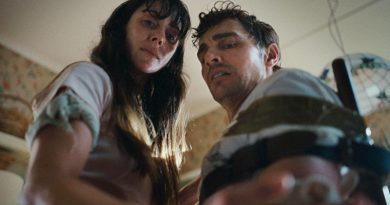Shelby Oaks Review: Chris Stuckmann’s Feature-Length Debut Has a Promising Opening Stretch Before The Movie Gradually Loses Steam
So, who took Riley Brennan in Shelby Oaks? The character in question, played by Sarah Durn, is the host of a ghost-hunting show called Paranormal Paranoids. For the first 20 minutes or so, YouTuber and film critic turned first-time feature filmmaker Chris Stuckmann begins with a promising opening stretch shot in an engrossing mix of found footage and faux-documentary style, complete with interview and news footage. We learn that Riley has mysteriously disappeared along with three other YouTubers while filming in the titular abandoned town located in Darke County.
Is the disappearance for real, or is it just an elaborate hoax for the sake of generating more views? Whatever the theory is, Stuckmann goes for the jugular at one point when you least expect it, before he switches the found footage/faux-documentary hybrid into a conventional filmmaking format. The latter somehow breaks the immersion of the initially creepy story surrounding the disappearance of the Paranormal Paranoids crew, particularly Riley.
The transition then focuses on Mia (Camille Sullivan), who desperately wants to find her missing sister, Riley, especially after a stranger shows up at her front door with the missing tape. Although Sullivan does a good job playing the fiercely determined older sister in search of an answer, the subsequent stretch of her searching for clues surprisingly lacks the intriguing structure to keep me engaged with the story.
The movie just goes through the motions with the obligatory things that go bump in the night and some jump scares, even though credit still goes to Stuckmann for trying his best by incorporating dread-inducing atmosphere with the help of Andrew Scott Baird’s cinematography and amplified by James Burkholder and The Newton Brothers’ riveting score.
The found-footage format still can be seen every now and then, but as the movie progresses, I can’t help but find that the ongoing story grows increasingly generic. And not to mention the glaring lapse in logic about a few things that bother me the most: The movie makes it look like Mia truly cares for her younger sister. And yet, despite knowing Riley is in town where she had disappeared in the first place, why not head there straight? And why does she need to wait until the possession of a videotape to finally convince her to become more proactive years after Riley’s disappearance?
Such a narrative oversight wouldn’t be frustrating if the movie had me distracted with enough scary moments to compensate for the shortcomings. Perhaps it would have helped if the movie had shown that Mia had tried to locate Riley in her earlier attempt before she gathered new information from watching the videotape years later. Shelby Oaks also includes the appearance of a demonic entity, suggesting something supernatural is going on, which may be tied to Riley’s disappearance. But the execution tells a different story, which again is devoid of the much-needed scare to elevate the movie from its mediocrity.
Then comes the eventual third-act reveal, where all I can say here is rather underwhelming. Instead of something that is shocking, it’s painfully derivative to the point I was wondering whether Stuckmann is losing his direction on what makes an effective horror movie. Even with Mike Flanagan listed as one of the executive producers and the fact that Shelby Oaks is backed by Neon, the same studio responsible for releasing Osgood Perkins‘ recent film projects, the end result is simply a disappointment. It’s a pity because I like the opening stretch, coupled with the introduction of Camille Sullivan’s engaging performance as Mia and some decent technical polish for a movie that only carries a very limited budget.





